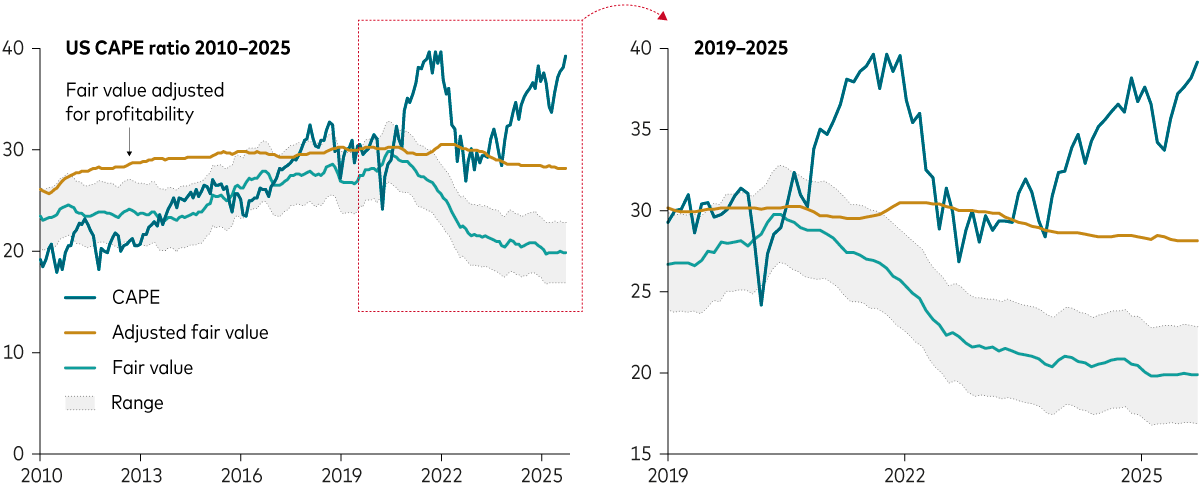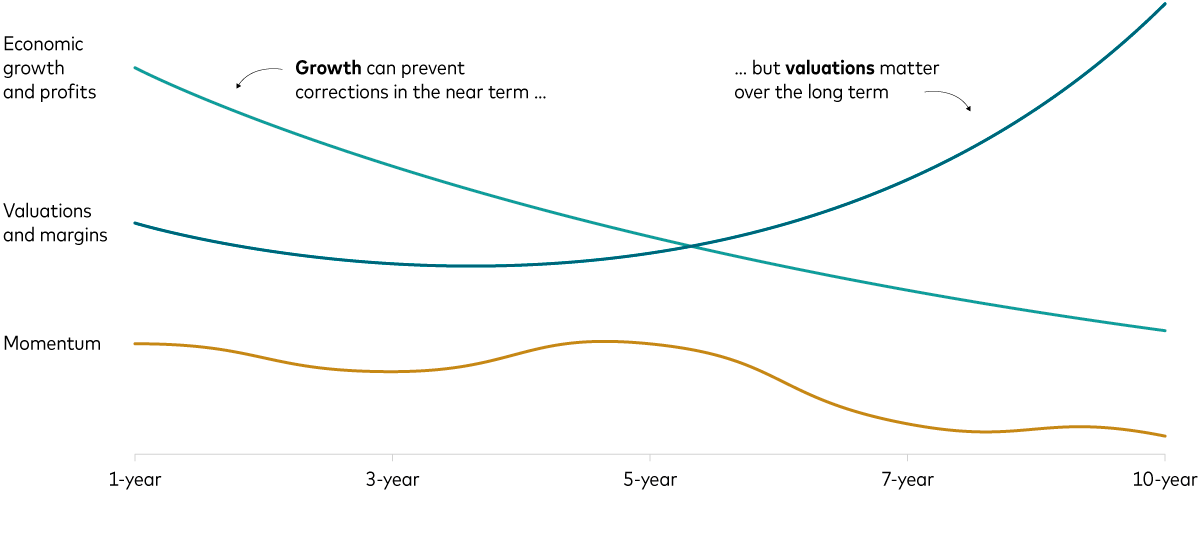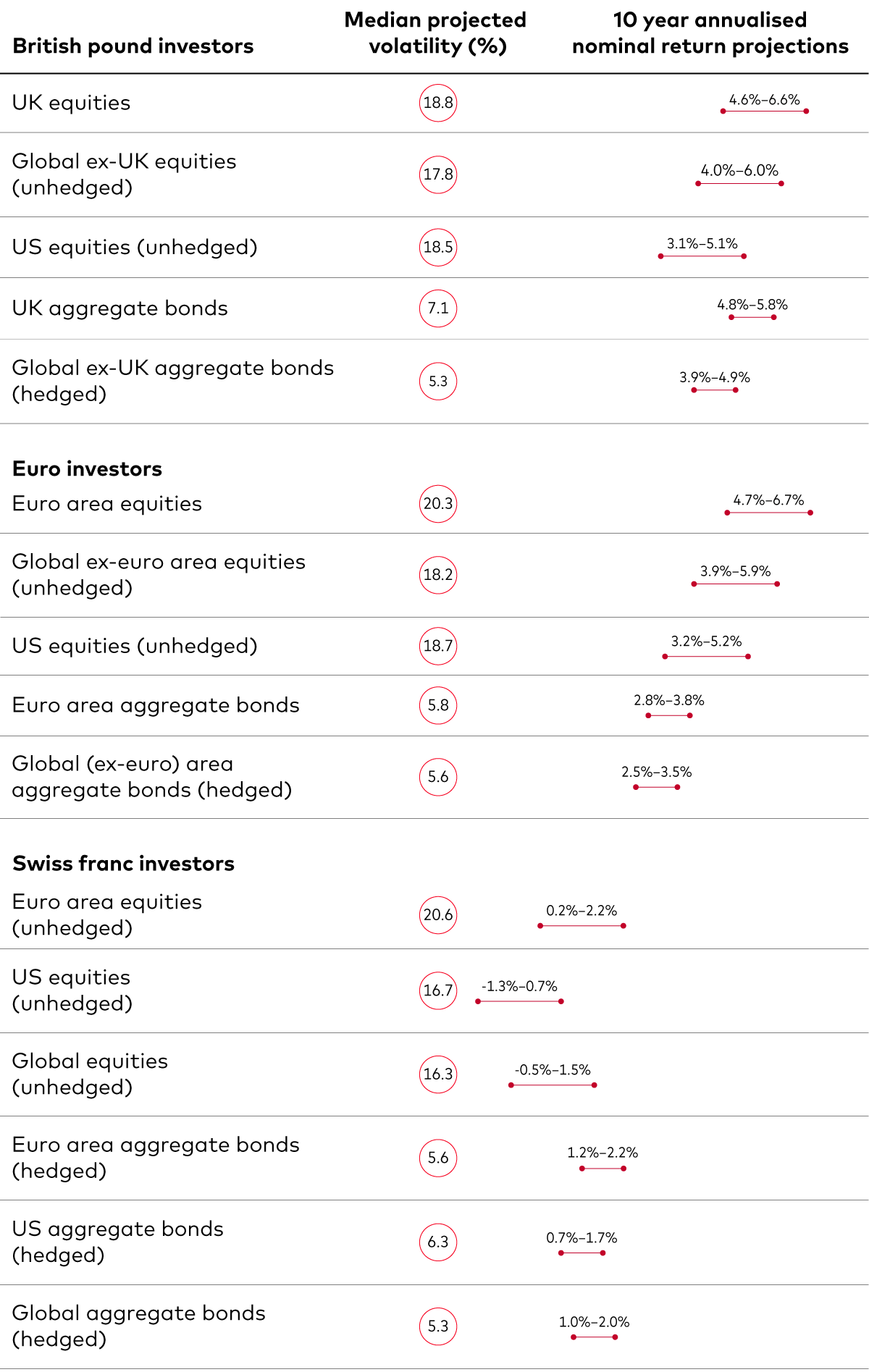Key points
- Economics and earnings often determine short-term equity returns. But valuations act like gravity over the long run, bringing returns closer to historical norms.
- US equity valuations are stretched – which could continue for a while but makes them more vulnerable to shocks in the near term.
- Across regions, investment, especially in technology and infrastructure, is proving a critical support for growth, but its impact is uneven and often offset by structural or policy headwinds.
For a few years, we’ve emphasised how overvalued US equities have become. And yet, driven by large tech companies, US equities continue to hit all-time highs. But unlike what we saw in the dot.com environment more than 25 years ago, US equities aren’t necessarily in a bubble.
Today’s tech leaders are generating real, strong profits. Factors including innovation, productivity, favourable regulation and strong corporate balance sheets can partly justify their lofty prices. However, the market often gets ahead of itself. When valuations are stretched with high hopes for the future, downside risk often outweighs upside potential.
Valuations act as gravity over the long run but not a timing tool
Elevated valuations alone typically don’t trigger market corrections. But they do make the market more vulnerable to shocks, such as recession or geopolitical events, that can trigger a correction. Our research shows that over longer periods approaching 10 years or more, valuations act like gravity, eventually pulling returns back towards their historical norms. However, over shorter time horizons, economic and earnings growth play a greater role in determining returns.
Accordingly, in today’s market environment, we need to watch macroeconomic developments and earnings growth closely. Despite our more muted long-term return outlook, the combination of continued economic and earnings growth and expected US Federal Reserve (Fed) monetary policy easing to cushion downside risk - almost a Goldilocks scenario 1 - could continue to support US market returns in the near term.
However, renewed recession fears, disappointing earnings growth or less-than-expected Fed easing (perhaps due to sticky inflation and a rise in long-term inflation expectations) could pose downside risks to the market when valuations are already stretched. So could any pullback in AI-related capital expenditures, which appear to have supported US economic growth this year.
US equity valuations are stretched even after adjusting fair value

Notes: These charts show the cyclically adjusted price-to-earnings (CAPE) ratio for the MSCI USA Index relative to two estimates of fair value. The standard measure considers the level of interest rates and the 10-year annualised inflation rate. The adjusted measure includes annualised inflation, a hypothetical firm’s after-tax cost of debt, and potential earnings growth.
Sources: Vanguard calculations, based on data as at 30 September 2025, from Robert Shiller’s website, the US Bureau of Labor Statistics, the Federal Reserve Board, Refinitiv, and Global Financial Data.
Valuations matter in the long run for equity returns

Notes: This conceptual chart illustrates the factors that determine equity returns over different time horizons. Economic/earnings growth and market momentum can offset overvaluation and sustain short-term returns, but valuations matter more in the long run.
Sources: Vanguard.
Catalysts for international growth – it’s not all about AI
AI expectations have provided a major tailwind for the US market. If AI’s full potential is realised, US companies could continue to deliver strong growth. However, international companies - especially those in developed markets - may benefit even more from AI once it is widely applied, commercialised and integrated into the broader economy.
There are potential quick wins overseas, where AI and automation can drive significant improvements in productivity and efficiency, allowing companies to catch up to US peers. On the other hand, if AI fails to deliver as expected, non-US markets would likely have less of a pullback than US markets.
It's not only AI that could spur greater growth overseas. In Europe, for example, increased defence spending or policy shifts that are more supportive of economic growth could boost productivity and earnings. In Japan, a return to normal inflation, stronger domestic demand and continued corporate governance reform could lift earnings. Emerging markets, particularly China, present opportunities with technological breakthroughs and encouraging policy pivots but also risks due to persistent structural and geopolitical headwinds.
Furthermore, US dollar appreciation contributed to the stronger relative performance of the US market over the past decade. Currency exchange rates are less likely to be a tailwind for the US market going forward. There is room for further depreciation in the US dollar if global investors continue to diversify away from USD assets, and fiscal concerns could amplify this trend.
Global diversification still matters for portfolios
Our models indicate a likelihood that US equities will lag non-US stocks over the next decade. But there’s still a meaningful chance that US stocks will outperform. No one should go all in on either US or non-US investments. Instead, investors should be diversified and, for the long term, may want to tilt their portfolios a bit more towards international.
Diversification is, of course, about more than just returns. In a more fragmented world, countries are striving for self-sufficiency and business cycles are becoming less correlated. This makes global diversification even more important for reducing risk in portfolios.
Our economic outlook
United States
AI-related business investment provides a GDP backstop
While we expect a modest growth environment, recent data call attention to emerging upside risks. Chief among these is a surge in business investment, particularly in AI-related capital expenditures (capex). This wave of tech-driven capex has provided a meaningful backstop to 2025 GDP, with early data suggesting that growth otherwise would have been much weaker. If this momentum continues, aided by favourable financial conditions, only moderate tariff pass-through, and fiscal support, more positive growth scenarios could materialise.
Downside risks remain, however, particularly in the labour market, where job creation has been subdued. More importantly, the supply side of the economy is evolving rapidly in ways that add uncertainty. Immigration trends and the anticipated productivity gains from AI are reshaping labour and output dynamics, making it increasingly difficult to distinguish cyclical fluctuations from structural shifts, and introducing uncertainty around the sustainability of recent growth surprises. This evolving landscape warrants close attention, especially as policy and investment responses adapt to these new realities.
United States economic forecasts
|
GDP growth |
Unemployment rate |
Core inflation |
Monetary policy |
Year-end outlook |
1.4% |
4.5% |
3.1% |
4% |
Notes: GDP growth is defined as the fourth-quarter-over-fourth-quarter change in real (inflation-adjusted) GDP in the forecast year compared with the previous year. Unemployment rate is as of December 2025. Core inflation is the year-over-year percentage change in the Personal Consumption Expenditures price index, excluding volatile food and energy prices, as at December 2025. Monetary policy is the upper end of the Federal Reserve’s target range for the federal funds rate at year-end.
Source: Vanguard.
United Kingdom
Tighter fiscal policy to weigh on growth in 2026
UK growth during the past year has been healthy and close to its potential. Looking through the tariff and national insurance tax-hike frontrunning in Q1, growth in the first half of 2025 was quite balanced, with consumer spending, government spending and business investment all making meaningful contributions.
We are constructive on the outlook for the second half of the year. Solid investment in a highly uncertain trade environment in the first half was an encouraging signal for the second half. The government’s commitment to raise day-to-day spending will continue to be a positive impulse. We expect 2025 growth of 1.3%.
But growth in 2026 could be more muted. This is primarily because the chancellor of the exchequer will be forced to raise taxes in the Autumn Budget. We estimate the chancellor will need £20 billion to £30 billion of savings to meet fiscal rules to which she’s committed. We forecast growth of just 0.8% in 2026.
We no longer expect the Bank of England (BoE) to ease monetary policy again this year. Recent payroll data suggest the labour market is softening rather than collapsing. Broader economic activity shows no signs of material weakness yet. We push our expectation for the next BoE cut into 2026 and expect the bank rate to end 2026 at 3.25%.
United Kingdom economic forecasts
|
GDP growth |
Unemployment rate |
Core inflation |
Monetary policy |
Year-end outlook |
1.3% |
4.8% |
3.7% |
4% |
Notes: GDP growth is defined as the annual change in real (inflation-adjusted) GDP in the forecast year compared with the previous year. Unemployment rate is as of December 2025. Core inflation is the year-over-year change in the Consumer Prices Index, excluding volatile food, energy, alcohol, and tobacco prices, as of December 2025. Monetary policy is the Bank of England’s bank rate at year-end.
Source: Vanguard.
Euro area
Window for an additional rate cut appears to have closed
The euro area outlook is shaped by two opposing dynamics. The first is the drag on the economy from higher US tariffs, with the effective rate likely to have increased by around 15 percentage points by the end of 2025. The second is the tailwind from looser fiscal policy, led by Germany’s infrastructure package and greater EU-wide defence spending.
The inflation outlook remains benign. The European Central Bank (ECB) has achieved a “soft landing.” Inflation and inflation expectations are both tracking close to 2%, and wage growth has moderated materially.
A lack of softening in recent activity and inflation data suggests the window for an additional ECB “insurance cut” has closed. We are dropping what would have been the last cut from our forecast and now foresee the policy rate staying at 2% until the end of 2026. However, risks skew towards an inflation undershoot and additional monetary easing next year.
Euro area economic forecasts
|
GDP growth |
Unemployment rate |
Core inflation |
Monetary policy |
Year-end outlook |
1.3% |
6.3% |
2.2% |
2% |
Notes: GDP growth is defined as the annual change in real (inflation-adjusted) GDP in the forecast year compared with the previous year. Unemployment rate is as of December 2025. Core inflation is the year-over-year change in the Harmonized Indexes of Consumer Prices, excluding volatile energy, food, alcohol, and tobacco prices, as of December 2025. Monetary policy is the European Central Bank’s deposit facility rate at year-end.
Source: Vanguard.
Japan
Central bank’s rate-hike path remains intact
Japan’s economy is still expanding, supported by stable domestic demand and better-than-expected exports. Large manufacturers are reporting modestly firmer sentiment, and the activity of nonmanufacturers remains high. Meanwhile, investment in software and digitalisation continues to offset labour shortages. For smaller firms, however, pressure on margins is keeping sentiment fragile.
While the impact of earlier shocks, including elevated import prices and food costs, is expected to fade, underlying inflationary pressures remain. These are driven by structural labour shortages, which are exerting upward pressure on wages and reinforcing a virtuous cycle of wage growth and price increases compared with recent decades. (Japan struggled with economic stagnation and deflation for many years in the 1990s and 2000s.)
With the peak of trade uncertainty likely behind us and the economy proving resilient, we expect the Bank of Japan (BoJ) to proceed with policy normalisation, gradually moving interest rates higher as economic conditions evolve in line with its forecasts.
Japan economic forecasts
|
GDP growth |
Unemployment rate |
Core inflation |
Monetary policy |
Year-end outlook |
0.7% |
2.4% |
2.4% |
0.75% |
Notes: GDP growth is defined as the annual change in real (inflation-adjusted) GDP in the forecast year compared with the previous year. Unemployment rate is as of December 2025. Core inflation is the year-over-year change in the Consumer Price Index, excluding volatile fresh food prices, as of December 2025. Monetary policy is the Bank of Japan’s year-end target for the overnight rate.
Source: Vanguard.
China
Eyes on new five-year plan as growth moderates
Better-than-expected Q3 GDP growth of 4.8% year over year kept China’s 5% annual target within reach. Robust export activity continued to support industrial production despite mounting global trade uncertainty. Domestic challenges persist, however, and the gap between supply-side strength and weak domestic demand has widened. The GDP deflator, an output-related measure of price changes, was negative for the 10th time in 11 quarters, extending China’s historic deflationary stretch. Although a recent stock market rally has boosted financial sector output through increased trading activity, its broader expansionary impact on the real economy may be limited.
On the global stage, renewed trade tensions with the US could dampen market sentiment. However, the tensions have an aspect of strategic positioning ahead of a potential meeting of the nations’ leaders at the forthcoming Asia-Pacific Economic Cooperation summit.
We believe broad-based stimulus is unlikely in the near term. However, moderating growth, and especially weakness in investment, appears to have alerted policymakers to the need for some fiscal support, which should aid domestic demand into 2026, albeit modestly. We expect only a mild policy rate reduction of 10 basis points for the rest of the year to facilitate fiscal expansion. The forthcoming release of the 15th five-year plan will inform China’s structural policy agenda, offering high-level strategic guidance.
China economic forecasts
|
GDP growth |
Unemployment rate |
Core inflation |
Monetary policy |
Year-end outlook |
5% |
5.1% |
0.5% |
1.3% |
Notes: GDP growth is defined as the annual change in real (inflation-adjusted) GDP in the forecast year compared with the previous year. Unemployment rate is as of December 2025. Core inflation is the year-over-year change in the Consumer Price Index, excluding volatile food and energy prices, as of December 2025. Monetary policy is the People’s Bank of China’s seven-day reverse repo rate at year-end.
Source: Vanguard.
Asset-class return outlook
Vanguard has updated its 10-year annualised outlooks for broad asset class returns through the most recent running of the Vanguard Capital Markets Model® (VCMM), based on data as at 30 June 2025.
Our 10-year annualised nominal return projections2, expressed for local investors in local currencies, are as follows:

1A “Goldilocks scenario” refers to an economic environment that is “just right”- not too hot, not too cold- echoing the children’s fairy tale “Goldilocks and the Three Bears.” In financial markets, this means conditions are balanced between extremes, creating an optimal setting for growth and investment.
2 The figures are based on a 2-point range around the 50th percentile of the distribution of return outcomes for equities and a 1-point range around the 50th percentile for fixed income.
IMPORTANT: The projections or other information generated by the Vanguard Capital Markets Model® regarding the likelihood of various investment outcomes are hypothetical in nature, do not reflect actual investment results, and are not guarantees of future results. VCMM results will vary with each use and over time. The VCMM projections are based on a statistical analysis of historical data. Future returns may behave differently from the historical patterns captured in the VCMM. More important, the VCMM may be underestimating extreme negative scenarios unobserved in the historical period on which the model estimation is based.
The Vanguard Capital Markets Model® is a proprietary financial simulation tool developed and maintained by Vanguard’s primary investment research and advice teams. The model forecasts distributions of future returns for a wide array of broad asset classes. Those asset classes include US and international equity markets, several maturities of the U.S. Treasury and corporate fixed income markets, international fixed income markets, US money markets, commodities, and certain alternative investment strategies. The theoretical and empirical foundation for the Vanguard Capital Markets Model is that the returns of various asset classes reflect the compensation investors require for bearing different types of systematic risk (beta). At the core of the model are estimates of the dynamic statistical relationship between risk factors and asset returns, obtained from statistical analysis based on available monthly financial and economic data from as early as 1960. Using a system of estimated equations, the model then applies a Monte Carlo simulation method to project the estimated interrelationships among risk factors and asset classes as well as uncertainty and randomness over time. The model generates a large set of simulated outcomes for each asset class over several time horizons. Forecasts are obtained by computing measures of central tendency in these simulations. Results produced by the tool will vary with each use and over time.
The primary value of the VCMM is in its application to analysing potential client portfolios. VCMM asset-class forecasts—comprising distributions of expected returns, volatilities, and correlations—are key to the evaluation of potential downside risks, various risk–return trade-offs, and the diversification benefits of various asset classes. Although central tendencies are generated in any return distribution, Vanguard stresses that focusing on the full range of potential outcomes for the assets considered, such as the data presented in this paper, is the most effective way to use VCMM output.
The VCMM seeks to represent the uncertainty in the forecast by generating a wide range of potential outcomes. It is important to recognise that the VCMM does not impose “normality” on the return distributions, but rather is influenced by the so-called fat tails and skewness in the empirical distribution of modelled asset-class returns. Within the range of outcomes, individual experiences can be quite different, underscoring the varied nature of potential future paths. Indeed, this is a key reason why we approach asset-return outlooks in a distributional framework.
Investment risk information
The value of investments, and the income from them, may fall or rise and investors may get back less than they invested.
Any projections should be regarded as hypothetical in nature and do not reflect or guarantee future results.
Important information
For professional investors only (as defined under the MiFID II Directive) investing for their own account (including management companies (fund of funds) and professional clients investing on behalf of their discretionary clients). In Switzerland for professional investors only. Not to be distributed to the public.
The information contained herein is not to be regarded as an offer to buy or sell or the solicitation of any offer to buy or sell securities in any jurisdiction where such an offer or solicitation is against the law, or to anyone to whom it is unlawful to make such an offer or solicitation, or if the person making the offer or solicitation is not qualified to do so. The information does not constitute legal, tax, or investment advice. You must not, therefore, rely on it when making any investment decisions.
The information contained herein is for educational purposes only and is not a recommendation or solicitation to buy or sell investments.
Issued in EEA by Vanguard Group (Ireland) Limited which is regulated in Ireland by the Central Bank of Ireland.
Issued in Switzerland by Vanguard Investments Switzerland GmbH.
Issued by Vanguard Asset Management, Limited which is authorised and regulated in the UK by the Financial Conduct Authority.
© 2025 Vanguard Group (Ireland) Limited. All rights reserved.
© 2025 Vanguard Investments Switzerland GmbH. All rights reserved.
© 2025 Vanguard Asset Management, Limited. All rights reserved
